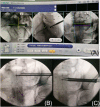Robot-assisted percutaneous screw placement combined with pelvic internal fixator for minimally invasive treatment of unstable pelvic ring fractures
- PMID: 29920914
- PMCID: PMC6175104
- DOI: 10.1002/rcs.1927
Robot-assisted percutaneous screw placement combined with pelvic internal fixator for minimally invasive treatment of unstable pelvic ring fractures
Abstract
Purpose: The purpose of this study was to investigate the safety and efficacy of the combination of robot-assisted percutaneous screw placement and pelvic internal fixator (INFIX) for minimally invasive treatment of unstable anterior and posterior pelvic ring injuries.
Methods: From September 2016 to June 2017, twenty-four patients with unstable anterior and posterior pelvic ring injuries were treated with TiRobot-assisted percutaneous sacroiliac cannulated screw fixation on the posterior pelvic ring combined with robot-assisted pedicle screw placement in the anterior inferior iliac spine along with INFIX on the anterior pelvic ring. The results of the treatment, including surgery duration, fluoroscopy frequency, total drilling, amount of blood loss, fracture healing time, and postoperative functional outcomes were recorded and compared with another 21 similar patients who underwent conventional manual positioning surgery.
Results: The TiRobot group incurred significantly shorter duration of surgery; less fluoroscopy frequency, intraoperative bleeding, and total drilling than in the conventional group (P < 0.05). Postoperative radiological follow-up showed that all screws were in the safe area and no screw penetrated the cortex. All wounds healed by primary intention and no iatrogenic damage to the blood vessels, nerves, and organs occurred. Patients showed good tolerance to INFIX and reported no discomfort. The mean follow-up duration was 5.4 months; the fractures were all healed, no loss of reduction occurred, and the mean Majeed score at the last follow-up did not show any difference.
Conclusion: TiRobot-assisted percutaneous screw placement combined with INFIX for the anterior and posterior pelvic ring injuries is accurate, safe, less invasive, and shows satisfactory efficacy, suggesting it is a better method for minimally invasive treatment of unstable pelvic ring fractures.
Keywords: fracture fixation; internal; minimally invasive surgery; pelvis; robotics.
© 2018 The Authors The International Journal of Medical Robotics and Computer Assisted Surgery Published by John Wiley & Sons Ltd.
Figures






Similar articles
-
Robot-assisted Minimally-invasive Internal Fixation of Pelvic Ring Injuries: A Single-center Experience.Orthop Surg. 2019 Feb;11(1):42-51. doi: 10.1111/os.12423. Epub 2019 Feb 3. Orthop Surg. 2019. PMID: 30714333 Free PMC article.
-
Robot-assisted treatment of unstable pelvic fractures with a percutaneous iliac lumbar double rod fixation combined with a percutaneous pelvic anterior ring INFIX fixation.Int Orthop. 2020 Jun;44(6):1223-1232. doi: 10.1007/s00264-020-04522-z. Epub 2020 Apr 21. Int Orthop. 2020. PMID: 32318753 Free PMC article.
-
Comparative Study of Percutaneous Sacroiliac Screw with or without TiRobot Assistance for Treating Pelvic Posterior Ring Fractures.Orthop Surg. 2019 Jun;11(3):386-396. doi: 10.1111/os.12461. Epub 2019 May 11. Orthop Surg. 2019. PMID: 31077570 Free PMC article.
-
Robot-assisted versus conventional percutaneous sacroiliac screw fixation for posterior pelvic ring injuries: a systematic review and meta-analysis.Eur J Orthop Surg Traumatol. 2023 Jan;33(1):9-20. doi: 10.1007/s00590-021-03167-x. Epub 2021 Nov 29. Eur J Orthop Surg Traumatol. 2023. PMID: 34842991
-
Percutaneous sacroiliac screw fixation with a 3D robot-assisted image-guided navigation system : Technical solutions.Oper Orthop Traumatol. 2025 Feb;37(1):3-13. doi: 10.1007/s00064-024-00871-9. Epub 2024 Nov 18. Oper Orthop Traumatol. 2025. PMID: 39556213 Free PMC article. Review.
Cited by
-
Percutaneous Sacroiliac Screw Fixation: A Modified Screw Insertion Method Using Just 2 Fluoroscopy Views.Arch Bone Jt Surg. 2024;12(8):574-579. doi: 10.22038/ABJS.2024.77855.3589. Arch Bone Jt Surg. 2024. PMID: 39211565 Free PMC article.
-
A novel biplanar positioning technique to guide iliosacral screw insertion: a retrospective study.BMC Musculoskelet Disord. 2023 May 11;24(1):374. doi: 10.1186/s12891-023-06482-y. BMC Musculoskelet Disord. 2023. PMID: 37170257 Free PMC article.
-
Preoperative 3D printing planning technology combined with orthopedic surgical robot-assisted minimally invasive screw fixation for the treatment of pelvic fractures: a retrospective study.PeerJ. 2024 Dec 12;12:e18632. doi: 10.7717/peerj.18632. eCollection 2024. PeerJ. 2024. PMID: 39677955 Free PMC article.
-
Navigation and 3D-imaging in pelvic ring surgery: a systematic review of prospective comparative studies.Arch Orthop Trauma Surg. 2024 Oct;144(10):4549-4559. doi: 10.1007/s00402-024-05468-2. Epub 2024 Jul 28. Arch Orthop Trauma Surg. 2024. PMID: 39068618
-
Accuracy and Safety of Robot-Assisted versus Fluoroscopy-Guided Posterior C1 Lateral Mass and C2 Pedicle Screw Internal Fixation for Atlantoaxial Dislocation: A Preliminary Study.Biomed Res Int. 2022 Sep 12;2022:8508113. doi: 10.1155/2022/8508113. eCollection 2022. Biomed Res Int. 2022. PMID: 36132077 Free PMC article.
References
-
- Tile M. The management of unstable injuries of the pelvic ring. J Bone Joint Surg Br. 1999;81(6):941‐943. - PubMed
-
- Van den Bosch EW, Van der Kleyn R, Hogervorst M, Van Vugt AB. Functional outcome of internal fixation for pelvic ring fractures. J Trauma. 1999;47(2):365‐371. - PubMed
-
- Stevenson AJ, Swartman B, Bucknill AT. Percutaneous internal fixation of pelvic fractures. German version. Unfallchirurg. 2016;119(10):825‐834. - PubMed
-
- Gautier E, Bächler R, Heini PF, Nolte LP. Accuracy of computer‐guided screw fixation of the sacroiliac joint. Clin Orthop Relat Res. 2001;393:310‐317. - PubMed
MeSH terms
LinkOut - more resources
Full Text Sources
Other Literature Sources
Medical

